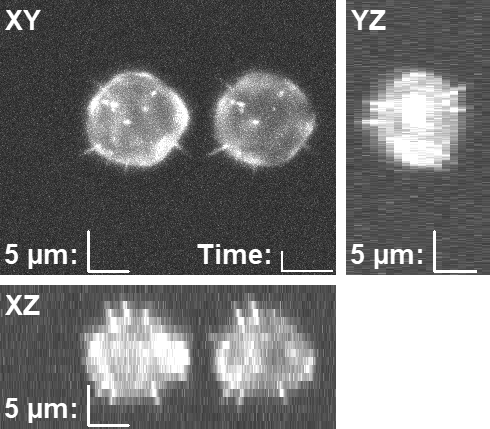Simulation of multiple interacting cells with filopodia
This web page supplements the paper entitled Model-Based Generation of Synthetic 3D Time-Lapse Sequences of Multiple Mutually Interacting Motile Cells with Filopodia. This paper describes a simulator of multiple mutually interacting cells with filopodial protrusions, which is capable of generating motile and touching cells with proactive, mechanics-based collision handling.
Summary
Complementing collections of 3D time-lapse image data with comprehensive manual annotations is an extremely laborious and often impracticable task, which hinders objective benchmarking of bioimage analysis workflows as well as training of widespread deep-learning-based approaches. In this paper, we present a novel simulation system capable of generating synthetic 3D time-lapse sequences of multiple mutually interacting cells with filopodial protrusions, accompanied by inherently generated reference annotations, in order to stimulate the development of fully 3D bioimage analysis workflows for filopodium segmentation and tracking in complex scenarios with multiple mutually interacting cells. The system integrates its predecessor, which was designed for single-cell, collision-unaware scenarios only, with proactive, mechanics-based handling of collisions between multiple filopodia, multiple cell bodies, or their combinations.
Sample Image Data
The image sequences presented in the paper are shown below (the intensities were modified with percentile stretch for better visibility):
-
The maximum intensity projection depicted below consists of three individual images:
(top-left) xy-projection, (top-right) yz-projection, and (bottom)xz-projection.
The complete image sequence of two interacting lung cancer cells accompanied by the binary ground truth: 2cells_with_filopodia.zip.
-
The maximum intensity projection depicted below consists of three individual images:
(top-left) xy-projection, (top-right) yz-projection, and (bottom) xz-projection.

The complete image sequence of three interacting lung cancer cells accompanied by the binary ground truth: 3cells_with_filopodia.zip.
Source Codes
The deformation module of the simulator is based on the SOFA framework (stable version 17.12.00). The main sources of SOFA can be downloaded here. The plugins and scenes required for simulating cell interactions can be found here. There are two plugins that must be compiled: SofaPardisoSolver that contains detailed instructions on how to compile it; and SofaBezierSkeletonization that contains only one component necessary to read VTK files of filopodia to reconstruct the beam object. The scene files are located under SofaCellSim (there is the python scene with three cells and the data necessary to run the scene).
The source code of realistic texture generation module can be found here, being dependent on the I3D library. The resulting .vtk files from the SOFA simulations must be used as an input for the texture generation module.
Conditions of Use
The sources and datasets provided are free of charge for noncommercial and research purposes. Their use for any other purpose is generally possible, but solely with the explicit permission of the authors. In case of any questions, please do not hesitate to contact us at xmaska@fi.muni.cz.
In addition, you are expected to include adequate references whenever you present or publish results that are based on the resources provided.
References
- Igor Peterlík, David Svoboda, Vladimír Ulman, Dmitry V. Sorokin, Martin Maška. Model-Based Generation of Synthetic 3D Time-Lapse Sequences of Multiple Mutually Interacting Motile Cells with Filopodia. In Simulation and Synthesis in Medical Imaging, 2018, pp. 71-79.
Acknowledgment
This work was supported by the Czech Science Foundation under the grant number GJ16-03909Y, the Russian Science Foundation under the grant number 17-11-01279, and the German Federal Ministry of Research and Education (BMBF) under the grant number 031L0102 (de.NBI).